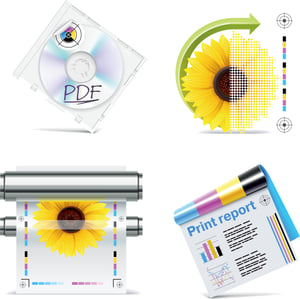
 Portable Document Format files (PDFs) are an efficient way of digitally sharing and outputting files across multiple platforms, including printing, losing no essential information in the transmission. Adobe introduced the file format almost 30 years ago.
Portable Document Format files (PDFs) are an efficient way of digitally sharing and outputting files across multiple platforms, including printing, losing no essential information in the transmission. Adobe introduced the file format almost 30 years ago.
Because PDF is now really an industry standard, a set of regulations was established and continues to be developed by the PDF Standards Committee. Specialized versions of PDFs have been created for specific purposes. PDF/a is for electronic document archives, and PDF/UA was formed for accessibility purposes. PDF/X drives general commercial printing, and variable and transactional documents use PDF/VT.
PDF/X ensures materials print exactly as designers create them, including images, colors, fonts, logos, and layout. Designers can include only static elements in these documents, meaning each impression in a print run must be similar.
High volume personalized documents like bills and statements use the PDF/VT standard, which makes it possible to print documents efficiently, where text and images change from page to page. Static elements such as lines, logos, and boxes are rasterized (RIP’d) once and stored, allowing the jobs to run much faster since the RIP must process only the page-specific variables.

PDF is not foolproof, however. Pre-press specialists often encounter issues with files they receive from customers and designers.
Listed below are some of the most common complications challenging printers attempting to process PDF files. Printers should encourage designers to contact them early, especially with variable print jobs, so experts can aid with specific requirements necessary to output the designs.
Fonts
Fonts are one of the biggest PDF frustrations. Designers sometimes choose unusual fonts for their creations and then fail to supply the fonts to the printer. All fonts used in the project must be embedded in the PDF. The font embedding process may differ among design software. Designers can use Adobe Acrobat to view the PDF specifications of their files, ensuring they have embedded all the fonts before sending them to the printer.
In rare cases, designers may create a font outline. This turns a font into a vector image. The disadvantage to this approach is the text cannot be edited.
Image Resolutions and Clarity
A sharp printed image must be at least 300 dots per inch. This resolution applies to photos, logos, and graphics. But extra high resolution can also be a problem. For most applications, markedly high resolution graphics do not improve the print quality; but they do slow down the RIPing process.
Another issue associated with photos and graphics is cropping. Instead of hiding excess areas of a graphic with a clipping path, designers should remove the unnecessary sections and re-size the image. The RIP still processes extra, unprinted portions of graphics, extending the time necessary to run the job.
graphic with a clipping path, designers should remove the unnecessary sections and re-size the image. The RIP still processes extra, unprinted portions of graphics, extending the time necessary to run the job.
Color
Designers work on monitors that display colors made of red, blue, and green pixels (RGB). They may forget that print devices use cyan, magenta, yellow, and black (CMYK). Before creating a PDF, designers must convert their project’s colors to CMYK, which can sometimes change the colors slightly. Printers must inform the customers if an exact color match will require special inks and increased costs.
PDFs offer designers flexibility while still providing a good portion of the standardization printers need to produce high quality output consistent with the design, across multiple platforms. The graphics industry enjoys the ease and consistency PDFs bring to managing digital output. But nearly three decades after their introduction, constructing a proper PDF still requires some vigilance.

In 2001, Roger Gimbel founded Gimbel & Associates, an international consulting firm providing business and market development services, skills training, and expert public speaking in the graphic communications and digital solutions industry. The mission of Gimbel & Associates is to help clients identify new business opportunities and implement leading-edge solutions using expertise in organizational development, technology selection, implementation, and work processes.
Roger oversees a team of Consultants with expertise in sales training, workflow analysis, MicroModeling, multichannel marketing, marketing plans, transactional printing, trans-promotional applications and creative strategies for mergers and acquisitions, business development workshops and seminars.










